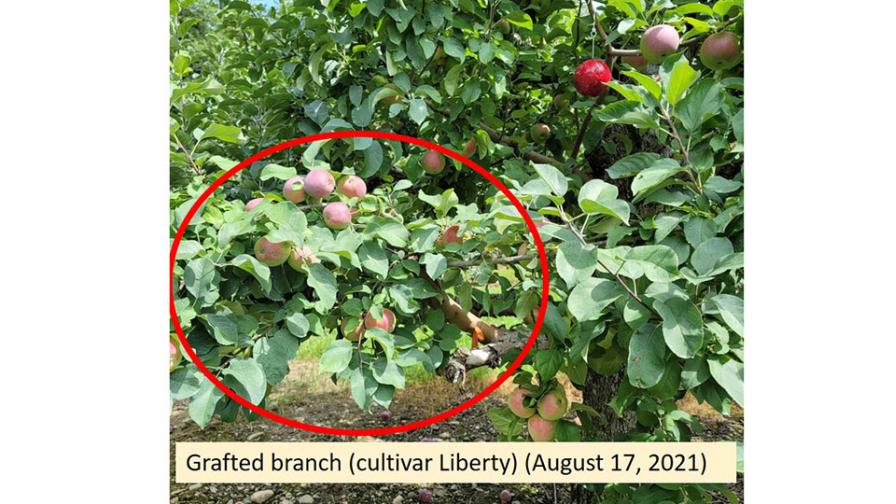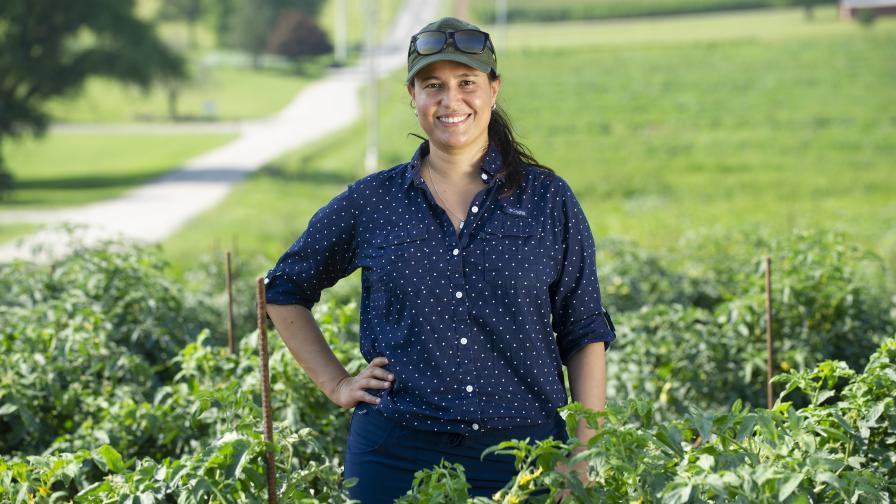Pest Alert: Plum Curculio Capturing Attention of Growers
What insect caused the most damage to New England apple orchards in 2021? If your answer is brown marmorated stink bug, tarnished plant bug, apple maggot, rollers, oriental fruit moth, codling moth, European apple sawfly, or San Jose scale, you would be incorrect.
Topping the list of insects last season — admittedly a mild campaign for such pests — was the plum curculio, according to Jaime Pinero, an Extension Professor with the University of Massachusetts.
“Overall insect pest activity was much lower than normal,” Pinero says. “However, plum curculio was causing damage as usual.”
Plum curculio is considered one of the most serious insect pests of apples in New England and among the most destructive
of peaches, according to the UMass Extension Fruit Program. It also attacks plum, pear, cherry, apricot, and blueberry
in southern states.
Pinero recorded the average levels of fruit injury at harvest last season across nine commercial apple orchards in Massachusetts, New Hampshire, and Maine. The grower standard was applied in each case.
The percentage of plum curculio-infested fruit was significantly higher in comparison with the remaining eight insects that were studied. Damage in the perimeters, interiors, and whole blocks was 5%, 3%, and 4%, respectively, the latter of which exceeded an average plum curculio season, Pinero says. The next-closest insect was tarnished plant bug, at 0.5% to 1% in the three categories.
Compared to the 2020 season, whole-block injury by plum curculio was far greater in 2021. One orchard was five to six times worse.
“Something happened with plum curculio control in 2021, which may be related to lack of insecticide coverage or timing,” Pinero says. “I think most important is timing.”
Whole blocks should be sprayed at petal fall, Pinero says. Female plum curculios start laying their eggs as soon as the fruit is 5 to 6 millimeters in diameter, preferentially in the king fruit.
A whole-block insecticide spray of all trees at petal fall will control not only plum curculio but also multiple pests, Pinero says. This can be followed by one or two sprays of the perimeter rows, he adds.
“Some Massachusetts growers have been following this for many years,” he says.
INSECTICIDE EFFICACY
The performance of insecticides depends on product characteristics, Pinero says. For example, an organophosphate, such as the phosmet Imidan (Gowan), and the carbaryl Sevin (Bayer) work primarily as contact poisons on adult plum curculio. As a thinner, Sevin applied at high rates can provide some level of protection against plum curculio at petal fall.
“I know some growers have been using Sevin at a high rate when there is the coincidence of thinning and controlling plum curculio,” Pinero says. “The level of efficacy of carbaryl is kind of moderate. It’s not a highly effective material, but it can help, especially when there is a coincidence with thinning and plum curculio activity.”
Avaunt (indoxacarb, FMC) works primarily by contact activity, but its efficacy increases when the insect ingests the material.
An Environmental Impact Quotient (EIQ) comparison of eight non-pyrethroid insecticides determined that the highest totals — meaning greatest negative impact — belonged to Imidan (48.8) and Sevin (30.1).
Some “safer” options, Pinero says, are Exirel (cyantraniliprole, FMC) and Verdepryn (cyclaniliprole, Summit Agro USA). Such diamide insecticides are translaminar, meaning they penetrate the leaf tissue and make reservoirs of their active ingredients. After rainfall, there is still some residual effect.
Pinero’s team also conducted a 2021 evaluation of Verdepryn while comparing it to Avaunt in the treatment of six sampled blocks at Cold Spring Orchard, the UMass research facility. On average, the blocks sprayed with Verdepryn received 1.2% injury, which was “no different” from Avaunt, Pinero says.
A tree fruit grower in Rhode Island who decided to evaluate Verdepryn alone recorded a 0.26% level of injury, which equals only two or three apples per thousand, Pinero says.
TRAP TREES
Finally, Pinero and New Hampshire grower Steve Wood, a former American Fruit GrowerSM Apple Grower of the Year award recipient, have been working since 2018 on the development of a permanent, low-cost trap cropping system for multiple apple pests via multi-cultivar grafting. As of 2021, the study involved 15 blocks, with four more to be added this year.
Three to four perimeter-row trees per acre are selected. Each tree is then grafted with six cultivars — ‘Liberty’, ‘Wickson’, ‘Ginger Gold’, ‘Dabinett’, ‘Yellow Transparent’, and ‘Red Astrachan’ — that are very attractive to plum curculio and apple maggot fly.
“The concept is simple, affordable, and grower friendly,” Pinero says. “How effective is this? This is a long-term project — it’s going to be more than eight years before we get the final data.”

A grafted branch featuring the cultivar ‘Liberty’.
Photo by Jaime Pinero
Nonetheless, results from 2021 are promising. The six cultivars combined incurred an average of 20% plum curculio injury in their nine Massachusetts-based blocks. Stock branches on the same trees also resulted in 20% injury, meaning that plum curculios do aggregate within the canopies of multi-cultivar grafted trees. Meanwhile, the perimeter-row non-grafted trees in the same blocks experienced an average of only 5% injury.
“The grafted trees had four times more injury in 2021, which are great results,” Pinero says. “This seems to be working for plum curculio.”










